Photography courtesy of Lowell Washburn, all rights reserved.
Winter Adventures Provide Both Fond & Not So Fond Memories
Frostbite Creek got its name when my friend Ross Dirks, almost lost his hand there. The incident occurred during a 2019 falconry duck hunt. Environmental conditions were downright polar that day; an unbearable blend of howling wind, blowing snow, and a wind chill that had dropped to thirty below. Ross was flying his Siberian goshawk who true to her heritage, seemed quite at home with the current weather.
When we jumped a big flock of ducks, the ‘gos had quickly overtaken a fat mallard. Unfortunately, the flight ended back in the water. Leaping into the shallow creek bed, Dirks hurriedly picked up his hawk and traded the duck for a tidbit. Although brief, the exchange required the removal of Ross’ right glove. In the short time it was exposed, the hand froze. I don’t mean that his hand was just very very cold, but literally tissue damaging frozen. Although the incident proved extremely painful and involved the later loss of sluffing skin, Dirks retained all of his fingers. Not surprisingly, his right hand remains weather sensitive to this day. A not so fond memory.

Most of our winter hunts are far less threatening, of course. Like a kid waiting to open presents, Iowa’s late falconry duck seasons are something I look forward to all year long. But the winter duck hunts are not without challenge. The late season doesn’t even open until early January, which means most ducks have long since departed for the Sunny South. Nevertheless, there are a handful of northern Iowa streams that maintain limited stretches of duck attracting, open water. Some of those creeks host gatherings containing hundreds of birds which provide some of the year’s most exhilarating outings.
As I maneuvered my truck through a treacherous maze of drifted cornstalks, I was hoping today would be one of those exhilarating adventures. My destination was an isolated stretch of Frostbite Creek, the same stream where Ross and I shared that fateful subzero hunt.
Riding shotgun atop a carpeted perch on the passenger seat, my goshawk, Attila, patiently swayed with the rhythm of the wallowing vehicle. A seasoned veteran of the chase, Attila loves duck hunting even more than I do. Although we were already jacked for the impending hunt, our mood was further enhanced by the recorded sounds of live mallards echoing through the cab.
Rounding the section’s final hillside, I stopped the truck and cut the engine. Although I couldn’t see the water from our position, the creek’s streambed lay dead ahead. Eagerly stepping unto my gloved fist, Attila was ready to hunt.
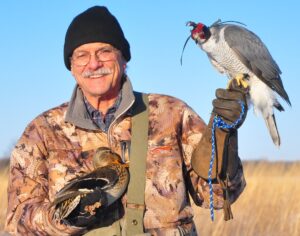
Opening the door, I received a chilling reminder of the current weather conditions. Afternoon temperature had only made it to the upper single digits and the wind was ripping out of the north at a solid 24 mph. The wind would present our biggest hinderance to achieving a successful hunt. In order to maintain his place, Attila tightened his grip, leaned into the breeze, and literally lay down on the glove. I thought about turning back. But despite the adverse conditions, the prospect of finding game lured us on.
As we neared the stream bank, our approach slowed from a brisk walk to stooped over crawl. With each creeping step, Attila became increasingly focused; ready to detonate at the first sign of game.
With the creek bank just yards away, we came to a complete halt. Crouching in anticipation, we were primed and ready. All we needed now were some ducks near where I thought they should be. Suspense was mounting. Ducks or no ducks, our moment of truth had arrived. Rising to my feet, I rushed to the creek.
Arriving at the water, I was relieved to see groups of mallards on both sides of our position. My sudden appearance did not go unnoticed, of course. As quickly as I was spotted, the ducks took to the air with a roar of wings. Flying water, flailing wings, and mallard alarm calls filled the sky.
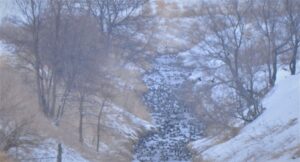
Attila’s response was immediate and decisive. Blasting from the fist, the hawk attained an instant radar lock on the duck he had selected. With an amazing burst of speed, the ‘gos hit the gas and was among the fleeing mallards in a blink. The flight reached its crescendo as the raptor seized a colorful drake and rode it to the ground. From start to finish, the entire flight had probably lasted less than five seconds.
Hurrying to the scene, I convinced Attila that a chicken drumstick would make a better meal than a warm, corn-fed mallard. After slipping the plump greenhead into my game bag, we began making our way back to the truck. By the time we arrived at the vehicle, the tracks we’d made coming in were mostly drifted full.
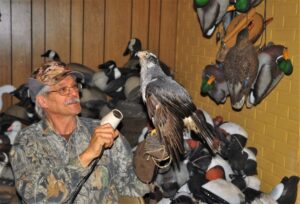
As we jostled our way back to the gravel, Attila contently tugged at the remnants of his chicken drummy. The wind, if anything, was picking up. Blowing snow continued to sculpt ever deepening drifts. If the gale didn’t back off soon, those drifts might become more than the truck could handle. So be it. If the corn stalk trail does become impassable, our final visit to Frostbite Creek will have provided a memorable conclusion to this year’s duck season.

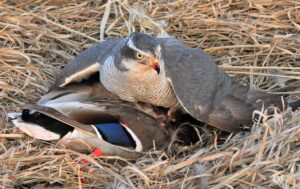
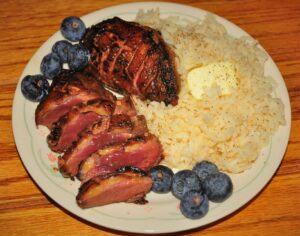
 Tom Cope
Tom Cope Sue Wilkinson
Sue Wilkinson Susan Judkins Josten
Susan Judkins Josten Rudi Roeslein
Rudi Roeslein Elyssa McFarland
Elyssa McFarland Mark Langgin
Mark Langgin Adam Janke
Adam Janke Joe Henry
Joe Henry Kristin Ashenbrenner
Kristin Ashenbrenner Joe Wilkinson
Joe Wilkinson Dr. Tammy Mildenstein
Dr. Tammy Mildenstein Sean McMahon
Sean McMahon